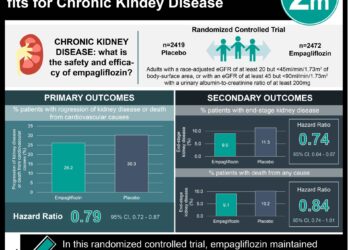No benefit of sodium bicarbonate or acetylcysteine for prevention of complications after angiography: The PRESERVE trial
1. Amongst patients undergoing angiography, neither sodium bicarbonate nor acetylcysteine were effective in preventing a composite outcome of death, need for dialysis, or persistent kidney injury.
2. The treatments were also ineffective in reducing risk of contrast-associated acute kidney injury.
Evidence Rating Level: 1 (Excellent)
Study Rundown: Contrast used in angiography is associated with numerous health risks including death, acute kidney injury, and chronic kidney injury. Intravenous sodium bicarbonate and oral acetylcysteine have been used based on theoretical mitigation of this risk, but their efficacy is unclear. The PRESERVE (Prevention of Serious Adverse Events Following Angiography) trial sought to investigate the efficacy of these treatment strategies in reducing the risk for a primary composite outcome of death, need for dialysis, or persistent kidney injury. No benefit was observed with used of intravenous bicarbonate compared to normal saline, and there was no benefit of oral acetylcysteine compared to placebo in rates of the primary outcome. Risk for acute kidney injury was not affected by the treatments. This trial provides robust evidence for lack of efficacy of sodium bicarbonate or acetylcysteine in prevention of angiography contrast-related complications amongst patients with kidney disease.
Strengths of the study include its randomized design and robust sample size. The use of a selected population with many patients from Veterans Affairs hospitals with chronic kidney disease undergoing angiography limits generalizability.
Click to read the study, published in NEJM
Relevant Reading: Economic burden of contrast-induced nephropathy: implications for prevention strategies
In-Depth [randomized controlled trial]: This was a multinational randomized controlled trial conducted from 2013 to 2017 that enrolled a total of 4993 patients for primary analysis. Patients were eligible for inclusion if they were scheduled to undergo angiography and had an estimated glomerular filtration rate of 15 to 44.9, or 45 to 59.9 and were diabetic. Exclusion criteria included emergency angiography or variable changes in blood creatinine within three days of the procedure. Patients were randomized in a 2×2 design, with 1.26% sodium bicarbonate (n = 2511) compared to 0.9% sodium chloride (n = 2482), and oral acetylcysteine (n = 2495) compared to placebo (n = 2498). The primary outcome was a composite of need for dialysis, persistent kidney injury, or death within 90 days. A key secondary end point was rate of contrast-induced kidney injury. Notably, 93.6% of patients were men and 80.9% had diabetes mellitus.
There was no difference in rate of the composite endpoint in the sodium bicarbonate group (4.4%) relative to the sodium chloride group (4.7%) (odds ratio [OR], 0.93; 95% confidence interval [CI], 0.72 to 1.22; p = 0.62). There was no difference in the primary outcome in the acetylcysteine group (4.6%) relative to the placebo group (4.5%) (OR, 1.02; 95%CI, 0.78 to 1.33; p = 0.88). There was no benefit of treatment with both bicarbonate and acetylcysteine (p for interaction = 0.33). There was no difference in risk of contrast-induced acute kidney injury in the treatment groups relative to the comparator groups (p = 0.46).
Image: CC/Wiki
©2018 2 Minute Medicine, Inc. All rights reserved. No works may be reproduced without expressed written consent from 2 Minute Medicine, Inc. Inquire about licensing here. No article should be construed as medical advice and is not intended as such by the authors or by 2 Minute Medicine, Inc.






